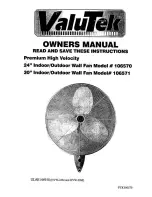
3.7
Precautions for connecting the ducts
Caution
Ensure to prevent any load of the ducts from acting on the fan.
Failure to observe this may cause a failure, damage, and/or vibration.
(1) In order to prevent transmission of vibration and noise to the outside, connect the fan’s flange
and the duct using an expansion joint. Note that giving too much deflection to the expansion
joint may cause pressure loss.
(2) Before connecting the ducts, check inside the ducts and fan, and remove any foreign matter,
such as waste cloth and tools.
(3) In general, unexpected pressure loss may occur due to the connection to (a) ducts that are
much smaller than the port diameter of the fan, (b) ducts with a series of bends, or (c) ducts
with bends just before or after the connection to the fan.
(4) If the opening area just in front of the air intake of the silencer box is significantly
reduced—for example by blocking the area with an iron plate, the air flow rate around the air
intake rises, which may cause damage to the sound absorbing material lined inside.
Warning
If the air intake of the silencer box is open, be sure to install a
protective wire mesh on it.
(5) To prevent foreign matter from being sucked into each place, install a protective wire mesh to
the duct inlet or the air intake of fan where air is sucked directly.
If dust or water is expected to get inside the fan or the silencer box, install a filter to protect
against it.
(6) If necessary, provide a damper for air volume control.
Do not install the damper close to the air intake of the silencer box.
Note
The gap between the air intake of the silencer box and the wall
should be equal to or larger than the long side of the air intake of the
silencer box.
3-6










































